Corporate Finance: Tertiary Sector Employees' Superannuation Plan
VerifiedAdded on 2021/05/31
|10
|2782
|16
Report
AI Summary
This report delves into the superannuation plan choices available to employees in the tertiary sector. It begins with an introduction to the tertiary sector and its economic role, followed by an overview of superannuation in Australia, including its origins and purpose. The report then explores two primary superannuation plan types: the defined benefit plan and the investment choice plan. For each plan, it outlines key features, factors to consider when choosing a plan, and the implications of early retirement. The defined benefit plan is examined in detail, including the formula used to calculate retirement benefits and the role of company trustees. The investment choice plan is also discussed, including investment strategies and factors influencing investment decisions. The report also touches on the time value of money, the effects of inflation, and the challenges faced by tertiary sector employees regarding retirement planning and service delivery. Finally, the report concludes by emphasizing the importance of informed decision-making in choosing a superannuation plan to secure financial well-being in retirement. The report also touches on the challenges faced by tertiary sector employees regarding retirement planning and service delivery.
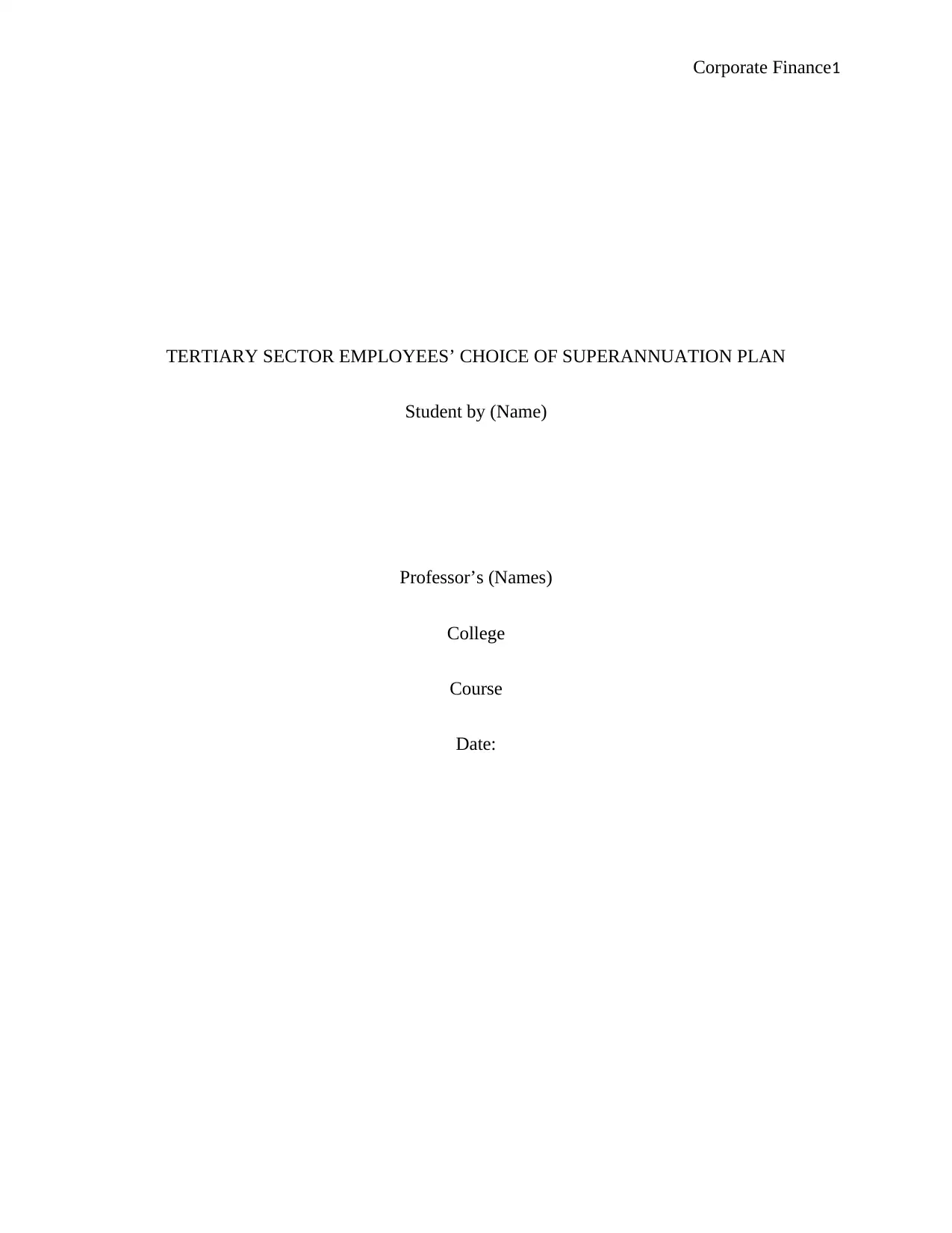
Corporate Finance1
TERTIARY SECTOR EMPLOYEES’ CHOICE OF SUPERANNUATION PLAN
Student by (Name)
Professor’s (Names)
College
Course
Date:
TERTIARY SECTOR EMPLOYEES’ CHOICE OF SUPERANNUATION PLAN
Student by (Name)
Professor’s (Names)
College
Course
Date:
Paraphrase This Document
Need a fresh take? Get an instant paraphrase of this document with our AI Paraphraser

Corporate Finance2
TERTIARY SECTOR EMPLOYEES’ CHOICE OF SUPERANNUATION PLAN
Introduction
Tertiary sector employees are people who work in a tertiary sector economy. It is among
the three sectors of the economy which comprises of intangible goods such as services, the
example of services offered are advice, experience, consumer services, banking and finance. The
other two sectors are the primary sector which is the first sector of economy comprising of
producing raw materials used in the second economy sector which is the secondary sector. The
secondary industry includes manufacturing of raw materials. After manufacturing in the
secondary area of the economy, the finished products are then packed and presented for sale in
the market. In the market, tertiary sector employees are now required to make a market decision
on where to purchase the finished goods and also market the products and services.
Superannuation
The super annual contribution was brought by the Australian government in inspiring
workers to save and finance for their imminent retirement plans. Superannuation contribution
was initiated by each employer contributing three percent of his salary to cater for the pension,
but it has grown to nine percent in two thousand and five. The reason for super annual influence
was conveyed for the determinations of eliminating affliction from the social sanctuary systems
for the provision of the pension payment to help employees in their retirement ages to ease their
lives. The super annual contribution is to enable workers to save; invest in gaining profits to
manage their ageing and also to help the non- working parties. Super annual and mutual
funding's now the leading in the Australia investments and also included in the equity security of
companies in both local and global share markets (Gallery, Newton and Palm 2011).
The paramount superannuation speculation option is constantly for those that invest or
the ones who have the best financial consultants. Superannuation options are the ones to make
TERTIARY SECTOR EMPLOYEES’ CHOICE OF SUPERANNUATION PLAN
Introduction
Tertiary sector employees are people who work in a tertiary sector economy. It is among
the three sectors of the economy which comprises of intangible goods such as services, the
example of services offered are advice, experience, consumer services, banking and finance. The
other two sectors are the primary sector which is the first sector of economy comprising of
producing raw materials used in the second economy sector which is the secondary sector. The
secondary industry includes manufacturing of raw materials. After manufacturing in the
secondary area of the economy, the finished products are then packed and presented for sale in
the market. In the market, tertiary sector employees are now required to make a market decision
on where to purchase the finished goods and also market the products and services.
Superannuation
The super annual contribution was brought by the Australian government in inspiring
workers to save and finance for their imminent retirement plans. Superannuation contribution
was initiated by each employer contributing three percent of his salary to cater for the pension,
but it has grown to nine percent in two thousand and five. The reason for super annual influence
was conveyed for the determinations of eliminating affliction from the social sanctuary systems
for the provision of the pension payment to help employees in their retirement ages to ease their
lives. The super annual contribution is to enable workers to save; invest in gaining profits to
manage their ageing and also to help the non- working parties. Super annual and mutual
funding's now the leading in the Australia investments and also included in the equity security of
companies in both local and global share markets (Gallery, Newton and Palm 2011).
The paramount superannuation speculation option is constantly for those that invest or
the ones who have the best financial consultants. Superannuation options are the ones to make
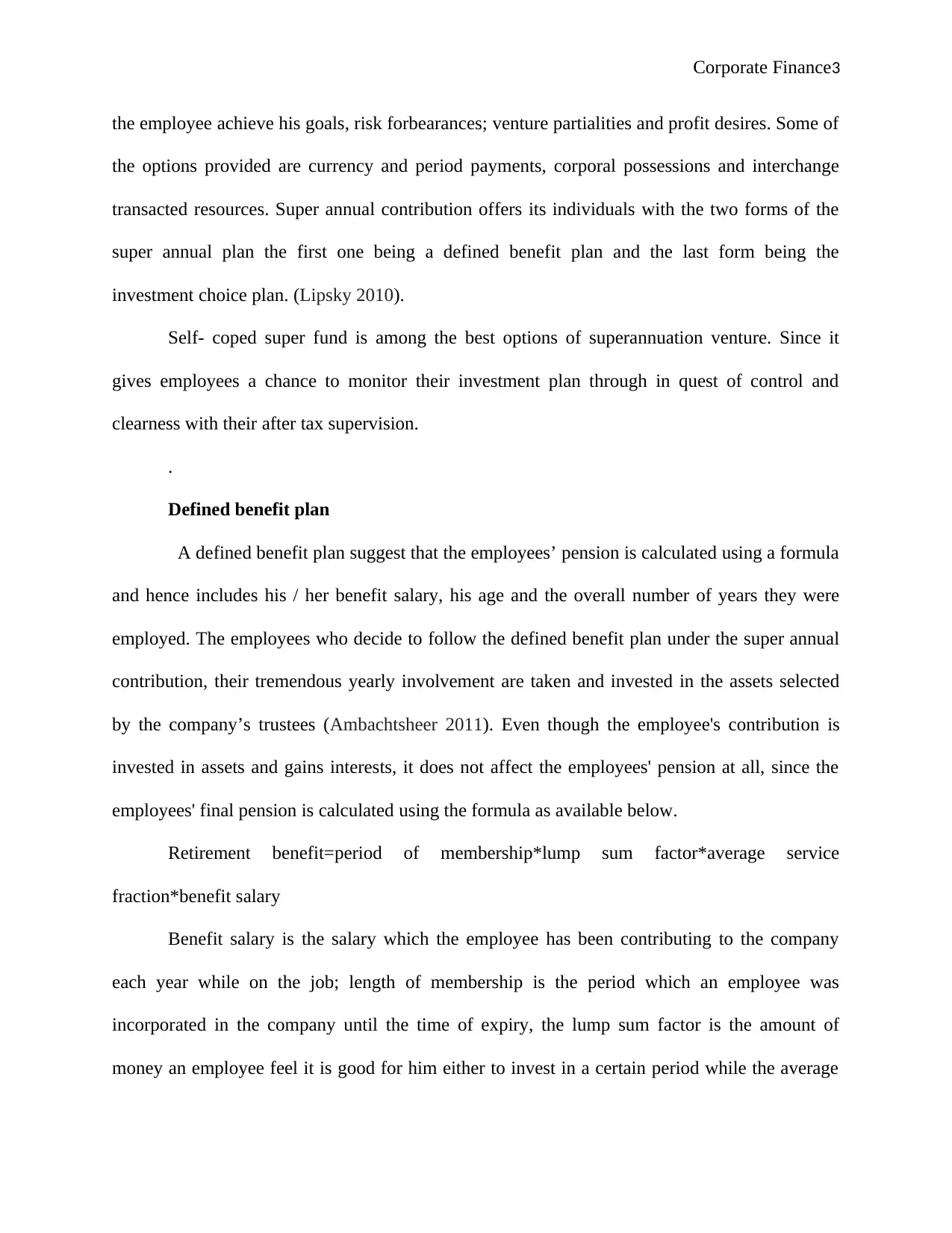
Corporate Finance3
the employee achieve his goals, risk forbearances; venture partialities and profit desires. Some of
the options provided are currency and period payments, corporal possessions and interchange
transacted resources. Super annual contribution offers its individuals with the two forms of the
super annual plan the first one being a defined benefit plan and the last form being the
investment choice plan. (Lipsky 2010).
Self- coped super fund is among the best options of superannuation venture. Since it
gives employees a chance to monitor their investment plan through in quest of control and
clearness with their after tax supervision.
.
Defined benefit plan
A defined benefit plan suggest that the employees’ pension is calculated using a formula
and hence includes his / her benefit salary, his age and the overall number of years they were
employed. The employees who decide to follow the defined benefit plan under the super annual
contribution, their tremendous yearly involvement are taken and invested in the assets selected
by the company’s trustees (Ambachtsheer 2011). Even though the employee's contribution is
invested in assets and gains interests, it does not affect the employees' pension at all, since the
employees' final pension is calculated using the formula as available below.
Retirement benefit=period of membership*lump sum factor*average service
fraction*benefit salary
Benefit salary is the salary which the employee has been contributing to the company
each year while on the job; length of membership is the period which an employee was
incorporated in the company until the time of expiry, the lump sum factor is the amount of
money an employee feel it is good for him either to invest in a certain period while the average
the employee achieve his goals, risk forbearances; venture partialities and profit desires. Some of
the options provided are currency and period payments, corporal possessions and interchange
transacted resources. Super annual contribution offers its individuals with the two forms of the
super annual plan the first one being a defined benefit plan and the last form being the
investment choice plan. (Lipsky 2010).
Self- coped super fund is among the best options of superannuation venture. Since it
gives employees a chance to monitor their investment plan through in quest of control and
clearness with their after tax supervision.
.
Defined benefit plan
A defined benefit plan suggest that the employees’ pension is calculated using a formula
and hence includes his / her benefit salary, his age and the overall number of years they were
employed. The employees who decide to follow the defined benefit plan under the super annual
contribution, their tremendous yearly involvement are taken and invested in the assets selected
by the company’s trustees (Ambachtsheer 2011). Even though the employee's contribution is
invested in assets and gains interests, it does not affect the employees' pension at all, since the
employees' final pension is calculated using the formula as available below.
Retirement benefit=period of membership*lump sum factor*average service
fraction*benefit salary
Benefit salary is the salary which the employee has been contributing to the company
each year while on the job; length of membership is the period which an employee was
incorporated in the company until the time of expiry, the lump sum factor is the amount of
money an employee feel it is good for him either to invest in a certain period while the average
⊘ This is a preview!⊘
Do you want full access?
Subscribe today to unlock all pages.

Trusted by 1+ million students worldwide
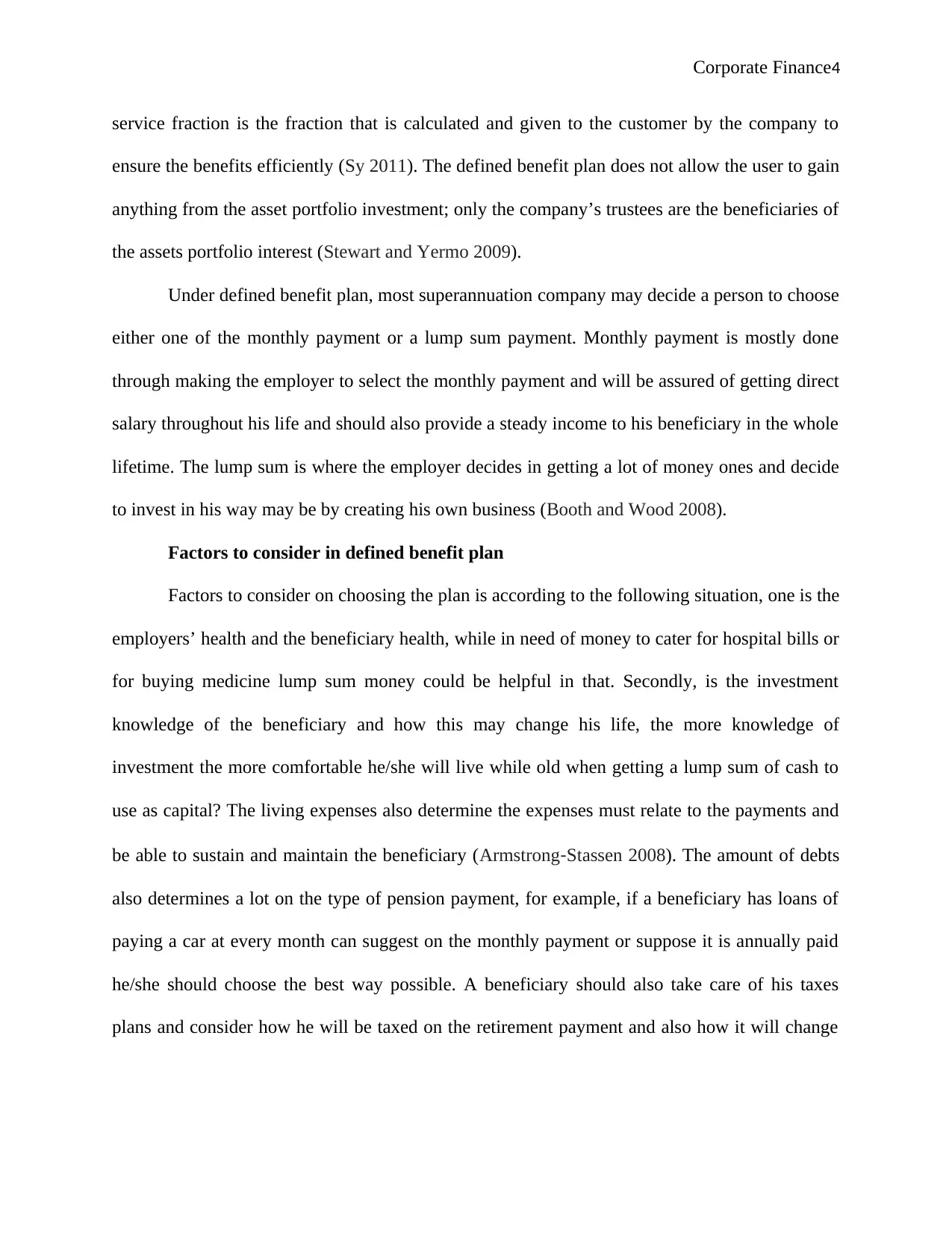
Corporate Finance4
service fraction is the fraction that is calculated and given to the customer by the company to
ensure the benefits efficiently (Sy 2011). The defined benefit plan does not allow the user to gain
anything from the asset portfolio investment; only the company’s trustees are the beneficiaries of
the assets portfolio interest (Stewart and Yermo 2009).
Under defined benefit plan, most superannuation company may decide a person to choose
either one of the monthly payment or a lump sum payment. Monthly payment is mostly done
through making the employer to select the monthly payment and will be assured of getting direct
salary throughout his life and should also provide a steady income to his beneficiary in the whole
lifetime. The lump sum is where the employer decides in getting a lot of money ones and decide
to invest in his way may be by creating his own business (Booth and Wood 2008).
Factors to consider in defined benefit plan
Factors to consider on choosing the plan is according to the following situation, one is the
employers’ health and the beneficiary health, while in need of money to cater for hospital bills or
for buying medicine lump sum money could be helpful in that. Secondly, is the investment
knowledge of the beneficiary and how this may change his life, the more knowledge of
investment the more comfortable he/she will live while old when getting a lump sum of cash to
use as capital? The living expenses also determine the expenses must relate to the payments and
be able to sustain and maintain the beneficiary (Armstrong‐Stassen 2008). The amount of debts
also determines a lot on the type of pension payment, for example, if a beneficiary has loans of
paying a car at every month can suggest on the monthly payment or suppose it is annually paid
he/she should choose the best way possible. A beneficiary should also take care of his taxes
plans and consider how he will be taxed on the retirement payment and also how it will change
service fraction is the fraction that is calculated and given to the customer by the company to
ensure the benefits efficiently (Sy 2011). The defined benefit plan does not allow the user to gain
anything from the asset portfolio investment; only the company’s trustees are the beneficiaries of
the assets portfolio interest (Stewart and Yermo 2009).
Under defined benefit plan, most superannuation company may decide a person to choose
either one of the monthly payment or a lump sum payment. Monthly payment is mostly done
through making the employer to select the monthly payment and will be assured of getting direct
salary throughout his life and should also provide a steady income to his beneficiary in the whole
lifetime. The lump sum is where the employer decides in getting a lot of money ones and decide
to invest in his way may be by creating his own business (Booth and Wood 2008).
Factors to consider in defined benefit plan
Factors to consider on choosing the plan is according to the following situation, one is the
employers’ health and the beneficiary health, while in need of money to cater for hospital bills or
for buying medicine lump sum money could be helpful in that. Secondly, is the investment
knowledge of the beneficiary and how this may change his life, the more knowledge of
investment the more comfortable he/she will live while old when getting a lump sum of cash to
use as capital? The living expenses also determine the expenses must relate to the payments and
be able to sustain and maintain the beneficiary (Armstrong‐Stassen 2008). The amount of debts
also determines a lot on the type of pension payment, for example, if a beneficiary has loans of
paying a car at every month can suggest on the monthly payment or suppose it is annually paid
he/she should choose the best way possible. A beneficiary should also take care of his taxes
plans and consider how he will be taxed on the retirement payment and also how it will change
Paraphrase This Document
Need a fresh take? Get an instant paraphrase of this document with our AI Paraphraser
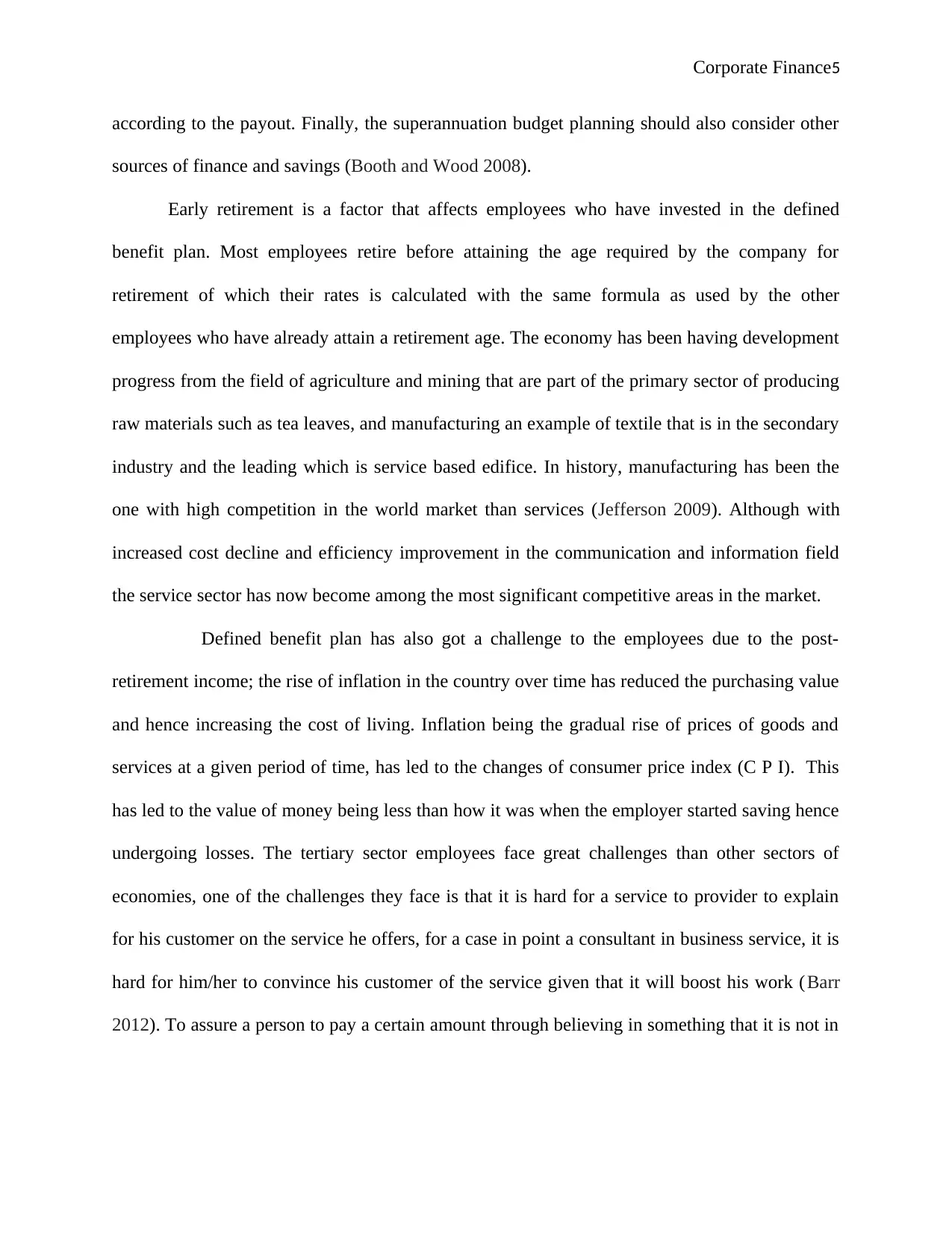
Corporate Finance5
according to the payout. Finally, the superannuation budget planning should also consider other
sources of finance and savings (Booth and Wood 2008).
Early retirement is a factor that affects employees who have invested in the defined
benefit plan. Most employees retire before attaining the age required by the company for
retirement of which their rates is calculated with the same formula as used by the other
employees who have already attain a retirement age. The economy has been having development
progress from the field of agriculture and mining that are part of the primary sector of producing
raw materials such as tea leaves, and manufacturing an example of textile that is in the secondary
industry and the leading which is service based edifice. In history, manufacturing has been the
one with high competition in the world market than services (Jefferson 2009). Although with
increased cost decline and efficiency improvement in the communication and information field
the service sector has now become among the most significant competitive areas in the market.
Defined benefit plan has also got a challenge to the employees due to the post-
retirement income; the rise of inflation in the country over time has reduced the purchasing value
and hence increasing the cost of living. Inflation being the gradual rise of prices of goods and
services at a given period of time, has led to the changes of consumer price index (C P I). This
has led to the value of money being less than how it was when the employer started saving hence
undergoing losses. The tertiary sector employees face great challenges than other sectors of
economies, one of the challenges they face is that it is hard for a service to provider to explain
for his customer on the service he offers, for a case in point a consultant in business service, it is
hard for him/her to convince his customer of the service given that it will boost his work (Barr
2012). To assure a person to pay a certain amount through believing in something that it is not in
according to the payout. Finally, the superannuation budget planning should also consider other
sources of finance and savings (Booth and Wood 2008).
Early retirement is a factor that affects employees who have invested in the defined
benefit plan. Most employees retire before attaining the age required by the company for
retirement of which their rates is calculated with the same formula as used by the other
employees who have already attain a retirement age. The economy has been having development
progress from the field of agriculture and mining that are part of the primary sector of producing
raw materials such as tea leaves, and manufacturing an example of textile that is in the secondary
industry and the leading which is service based edifice. In history, manufacturing has been the
one with high competition in the world market than services (Jefferson 2009). Although with
increased cost decline and efficiency improvement in the communication and information field
the service sector has now become among the most significant competitive areas in the market.
Defined benefit plan has also got a challenge to the employees due to the post-
retirement income; the rise of inflation in the country over time has reduced the purchasing value
and hence increasing the cost of living. Inflation being the gradual rise of prices of goods and
services at a given period of time, has led to the changes of consumer price index (C P I). This
has led to the value of money being less than how it was when the employer started saving hence
undergoing losses. The tertiary sector employees face great challenges than other sectors of
economies, one of the challenges they face is that it is hard for a service to provider to explain
for his customer on the service he offers, for a case in point a consultant in business service, it is
hard for him/her to convince his customer of the service given that it will boost his work (Barr
2012). To assure a person to pay a certain amount through believing in something that it is not in
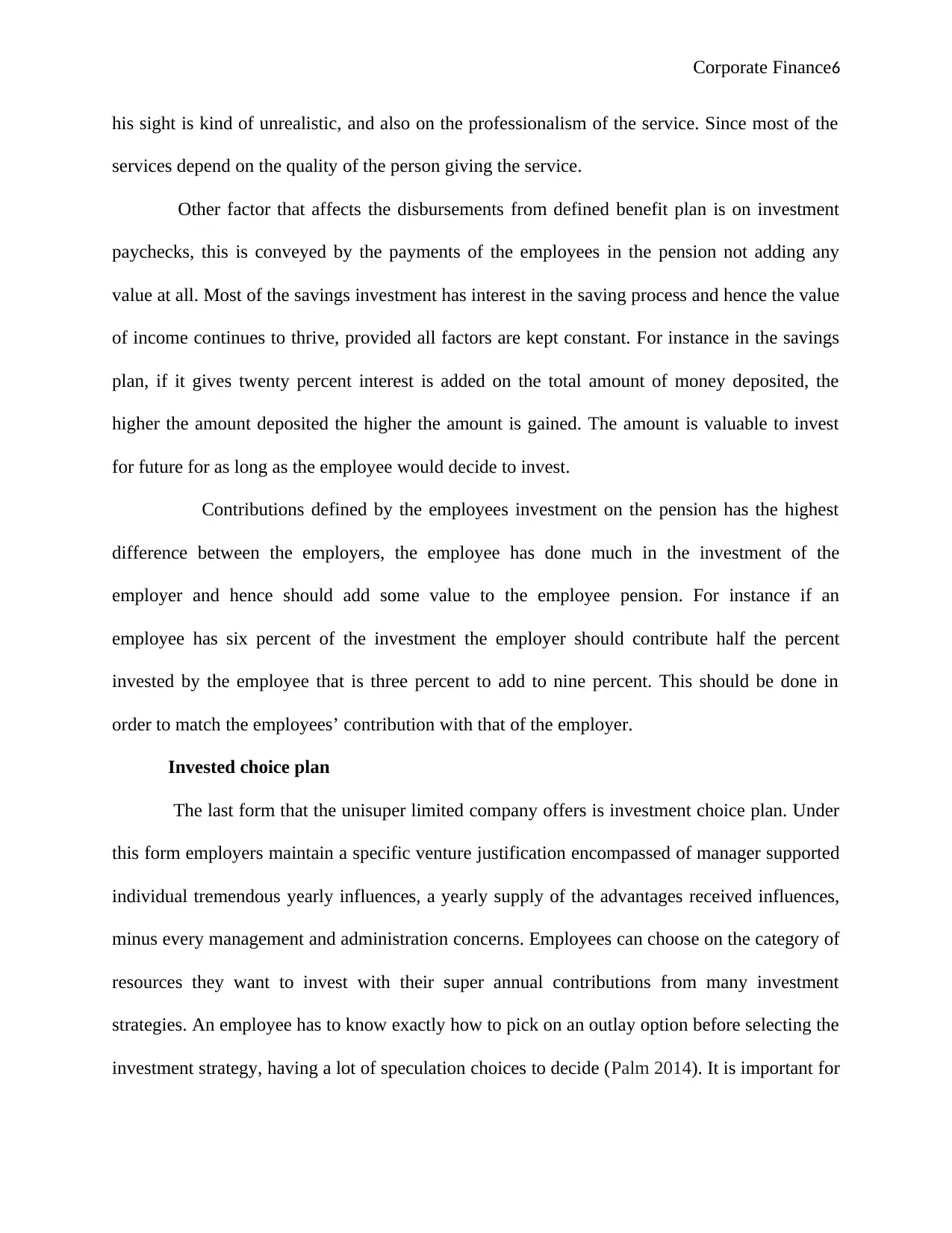
Corporate Finance6
his sight is kind of unrealistic, and also on the professionalism of the service. Since most of the
services depend on the quality of the person giving the service.
Other factor that affects the disbursements from defined benefit plan is on investment
paychecks, this is conveyed by the payments of the employees in the pension not adding any
value at all. Most of the savings investment has interest in the saving process and hence the value
of income continues to thrive, provided all factors are kept constant. For instance in the savings
plan, if it gives twenty percent interest is added on the total amount of money deposited, the
higher the amount deposited the higher the amount is gained. The amount is valuable to invest
for future for as long as the employee would decide to invest.
Contributions defined by the employees investment on the pension has the highest
difference between the employers, the employee has done much in the investment of the
employer and hence should add some value to the employee pension. For instance if an
employee has six percent of the investment the employer should contribute half the percent
invested by the employee that is three percent to add to nine percent. This should be done in
order to match the employees’ contribution with that of the employer.
Invested choice plan
The last form that the unisuper limited company offers is investment choice plan. Under
this form employers maintain a specific venture justification encompassed of manager supported
individual tremendous yearly influences, a yearly supply of the advantages received influences,
minus every management and administration concerns. Employees can choose on the category of
resources they want to invest with their super annual contributions from many investment
strategies. An employee has to know exactly how to pick on an outlay option before selecting the
investment strategy, having a lot of speculation choices to decide (Palm 2014). It is important for
his sight is kind of unrealistic, and also on the professionalism of the service. Since most of the
services depend on the quality of the person giving the service.
Other factor that affects the disbursements from defined benefit plan is on investment
paychecks, this is conveyed by the payments of the employees in the pension not adding any
value at all. Most of the savings investment has interest in the saving process and hence the value
of income continues to thrive, provided all factors are kept constant. For instance in the savings
plan, if it gives twenty percent interest is added on the total amount of money deposited, the
higher the amount deposited the higher the amount is gained. The amount is valuable to invest
for future for as long as the employee would decide to invest.
Contributions defined by the employees investment on the pension has the highest
difference between the employers, the employee has done much in the investment of the
employer and hence should add some value to the employee pension. For instance if an
employee has six percent of the investment the employer should contribute half the percent
invested by the employee that is three percent to add to nine percent. This should be done in
order to match the employees’ contribution with that of the employer.
Invested choice plan
The last form that the unisuper limited company offers is investment choice plan. Under
this form employers maintain a specific venture justification encompassed of manager supported
individual tremendous yearly influences, a yearly supply of the advantages received influences,
minus every management and administration concerns. Employees can choose on the category of
resources they want to invest with their super annual contributions from many investment
strategies. An employee has to know exactly how to pick on an outlay option before selecting the
investment strategy, having a lot of speculation choices to decide (Palm 2014). It is important for
⊘ This is a preview!⊘
Do you want full access?
Subscribe today to unlock all pages.

Trusted by 1+ million students worldwide

Corporate Finance7
the beneficiary to clearly understand the following factors such as indulgent of the benefit
sessions and menace; this will help the employee to invest wisely through having a better
understanding of the association amongst the risk and return of every venture. Secondly evaluate
his venture choices; subsequently, there are a lot of the venture choices available, but it is upon
the beneficiary to select from the one which yields good returns and which is less risky according
to its strategic asset allocation and performance through minimizing the losses. If he wants to
invest in an easily managed venture by himself, he can still select from the pre-mixed choices
from the company they have already designed to fit pension saving goals and easy with
speculation risk (Ntalianis and Wise 2011).
Factors to consider in investment choice plan
The venture strategies as provided by the investment choice plan are as follows, a
protected endowment that involves Australian static interest sanctuaries and money. The next
venture strategy is the trustees' collection reserve that stabilizes the supply of national and
foreign stocks, stuff properties and structure and reserved parity speculation (Speelman, Clark-
Murphy and Gerrans 2013). Thirdly is staked account that deals with venture exclusively in local
and foreign stocks, finally is steady endowment dealing in predominantly stable interest and
bond sanctuaries, with a minor acquaintance of local and foreign stocks and property. These
strategies being distinguished by their danger and profits traits, stake account having the highest
risk and can give huge losses and still has the highest average return while protected endowment
strategy being the last which has the smallest risk and having the lowest average return. This
concludes that the more the risk in investment strategy taken the higher the profits gained by the
strategy (Wagland and Taylor 2009).
Time value of money
the beneficiary to clearly understand the following factors such as indulgent of the benefit
sessions and menace; this will help the employee to invest wisely through having a better
understanding of the association amongst the risk and return of every venture. Secondly evaluate
his venture choices; subsequently, there are a lot of the venture choices available, but it is upon
the beneficiary to select from the one which yields good returns and which is less risky according
to its strategic asset allocation and performance through minimizing the losses. If he wants to
invest in an easily managed venture by himself, he can still select from the pre-mixed choices
from the company they have already designed to fit pension saving goals and easy with
speculation risk (Ntalianis and Wise 2011).
Factors to consider in investment choice plan
The venture strategies as provided by the investment choice plan are as follows, a
protected endowment that involves Australian static interest sanctuaries and money. The next
venture strategy is the trustees' collection reserve that stabilizes the supply of national and
foreign stocks, stuff properties and structure and reserved parity speculation (Speelman, Clark-
Murphy and Gerrans 2013). Thirdly is staked account that deals with venture exclusively in local
and foreign stocks, finally is steady endowment dealing in predominantly stable interest and
bond sanctuaries, with a minor acquaintance of local and foreign stocks and property. These
strategies being distinguished by their danger and profits traits, stake account having the highest
risk and can give huge losses and still has the highest average return while protected endowment
strategy being the last which has the smallest risk and having the lowest average return. This
concludes that the more the risk in investment strategy taken the higher the profits gained by the
strategy (Wagland and Taylor 2009).
Time value of money
Paraphrase This Document
Need a fresh take? Get an instant paraphrase of this document with our AI Paraphraser
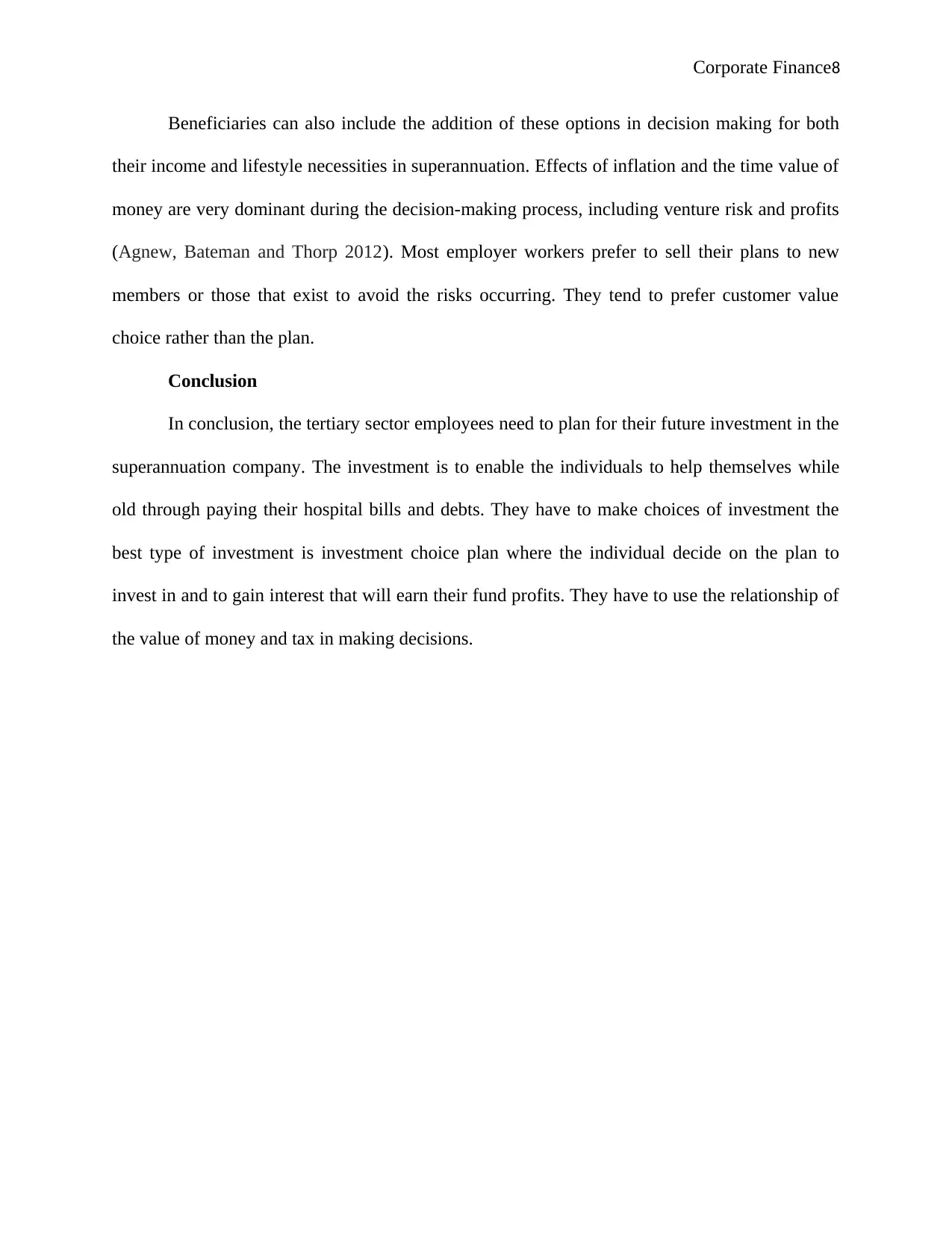
Corporate Finance8
Beneficiaries can also include the addition of these options in decision making for both
their income and lifestyle necessities in superannuation. Effects of inflation and the time value of
money are very dominant during the decision-making process, including venture risk and profits
(Agnew, Bateman and Thorp 2012). Most employer workers prefer to sell their plans to new
members or those that exist to avoid the risks occurring. They tend to prefer customer value
choice rather than the plan.
Conclusion
In conclusion, the tertiary sector employees need to plan for their future investment in the
superannuation company. The investment is to enable the individuals to help themselves while
old through paying their hospital bills and debts. They have to make choices of investment the
best type of investment is investment choice plan where the individual decide on the plan to
invest in and to gain interest that will earn their fund profits. They have to use the relationship of
the value of money and tax in making decisions.
Beneficiaries can also include the addition of these options in decision making for both
their income and lifestyle necessities in superannuation. Effects of inflation and the time value of
money are very dominant during the decision-making process, including venture risk and profits
(Agnew, Bateman and Thorp 2012). Most employer workers prefer to sell their plans to new
members or those that exist to avoid the risks occurring. They tend to prefer customer value
choice rather than the plan.
Conclusion
In conclusion, the tertiary sector employees need to plan for their future investment in the
superannuation company. The investment is to enable the individuals to help themselves while
old through paying their hospital bills and debts. They have to make choices of investment the
best type of investment is investment choice plan where the individual decide on the plan to
invest in and to gain interest that will earn their fund profits. They have to use the relationship of
the value of money and tax in making decisions.

Corporate Finance9
References
Agnew, J., Bateman, H. and Thorp, S., 2012. Financial Literacy and Retirement Planning in
Australian.
Ambachtsheer, K.P., 2011. Pension revolution: a solution to the pension’s crisis (Vol. 388). John
Wiley & Sons.
Armstrong‐Stassen, M., 2008. Organisational practices and the post‐retirement employment
experience of older workers. Human Resource Management Journal, 18(1), pp.36-53.
Barr, N., 2012. Economics of the welfare state. Oxford University Press.
Booth, A.L. and Wood, M., 2008. Back‐to‐Front Down Under? Part‐Time/Full‐Time Wage
Differentials in Australia. Industrial Relations: A Journal of economy and society, 47(1), pp.114-
135.
Capuano, A. and Ramsay, I., 2011. What causes suboptimal financial behaviour? An exploration
of financial literacy, social influences and behavioural economics.
Doherty, C., 2009. The appeal of the International Baccalaureate in Australia's educational
market: A curriculum of choice for mobile futures. Discourse: Studies in the cultural politics of
education, 30(1), pp.73-89.
Gallery, N., Gallery, G., Brown, K., Furneaux, C. and Palm, C., 2011. Financial literacy and
pension investment decisions. Financial Accountability & Management, 27(3), pp.286-307.
References
Agnew, J., Bateman, H. and Thorp, S., 2012. Financial Literacy and Retirement Planning in
Australian.
Ambachtsheer, K.P., 2011. Pension revolution: a solution to the pension’s crisis (Vol. 388). John
Wiley & Sons.
Armstrong‐Stassen, M., 2008. Organisational practices and the post‐retirement employment
experience of older workers. Human Resource Management Journal, 18(1), pp.36-53.
Barr, N., 2012. Economics of the welfare state. Oxford University Press.
Booth, A.L. and Wood, M., 2008. Back‐to‐Front Down Under? Part‐Time/Full‐Time Wage
Differentials in Australia. Industrial Relations: A Journal of economy and society, 47(1), pp.114-
135.
Capuano, A. and Ramsay, I., 2011. What causes suboptimal financial behaviour? An exploration
of financial literacy, social influences and behavioural economics.
Doherty, C., 2009. The appeal of the International Baccalaureate in Australia's educational
market: A curriculum of choice for mobile futures. Discourse: Studies in the cultural politics of
education, 30(1), pp.73-89.
Gallery, N., Gallery, G., Brown, K., Furneaux, C. and Palm, C., 2011. Financial literacy and
pension investment decisions. Financial Accountability & Management, 27(3), pp.286-307.
⊘ This is a preview!⊘
Do you want full access?
Subscribe today to unlock all pages.

Trusted by 1+ million students worldwide

Corporate Finance10
Gallery, N., Newton, C. and Palm, C., 2011. Framework for assessing financial literacy and
superannuation investment choice decisions. Australasian Accounting Business & Finance
Journal, 5(2), p.3.
Jefferson, T., 2009. Women and retirement pensions: A research review. Feminist
Economics, 15(4), pp.115-145.
Lipsky, M., 2010. Street-level bureaucracy, 30th ann. Ed.: dilemmas of the individual in public
service. Russell Sage Foundation.
Ntalianis, M. and Wise, V., 2011. The role of financial education in retirement
planning. Australasian Accounting Business & Finance Journal, 5(2), p.23.
Palm, C.T., 2014. Financial Literacy and Superannuation Investment Decision-making in a
choice environment: An exploratory study (Doctoral dissertation, Queensland University of
Technology).
Speelman, C.P., Clark-Murphy, M. and Gerrans, P., 2013. Decision making clusters in retirement
savings: Gender differences dominate. Journal of family and economic issues, 34(3), pp.329-339.
Stewart, F. and Yermo, J., 2009. Pension fund governance. OECD Journal: Financial Market
Trends, 2008(2), pp.1-42.
Sy, W.N., 2011. Redesigning choice and competition in Australian superannuation.
Wagland, S.P. and Taylor, S., 2009. When it comes to financial literacy, is gender really an
issue?. Australasian Accounting, Business and Finance Journal, 3(1), p.3.
Gallery, N., Newton, C. and Palm, C., 2011. Framework for assessing financial literacy and
superannuation investment choice decisions. Australasian Accounting Business & Finance
Journal, 5(2), p.3.
Jefferson, T., 2009. Women and retirement pensions: A research review. Feminist
Economics, 15(4), pp.115-145.
Lipsky, M., 2010. Street-level bureaucracy, 30th ann. Ed.: dilemmas of the individual in public
service. Russell Sage Foundation.
Ntalianis, M. and Wise, V., 2011. The role of financial education in retirement
planning. Australasian Accounting Business & Finance Journal, 5(2), p.23.
Palm, C.T., 2014. Financial Literacy and Superannuation Investment Decision-making in a
choice environment: An exploratory study (Doctoral dissertation, Queensland University of
Technology).
Speelman, C.P., Clark-Murphy, M. and Gerrans, P., 2013. Decision making clusters in retirement
savings: Gender differences dominate. Journal of family and economic issues, 34(3), pp.329-339.
Stewart, F. and Yermo, J., 2009. Pension fund governance. OECD Journal: Financial Market
Trends, 2008(2), pp.1-42.
Sy, W.N., 2011. Redesigning choice and competition in Australian superannuation.
Wagland, S.P. and Taylor, S., 2009. When it comes to financial literacy, is gender really an
issue?. Australasian Accounting, Business and Finance Journal, 3(1), p.3.
1 out of 10
Related Documents
Your All-in-One AI-Powered Toolkit for Academic Success.
+13062052269
info@desklib.com
Available 24*7 on WhatsApp / Email
![[object Object]](/_next/static/media/star-bottom.7253800d.svg)
Unlock your academic potential
Copyright © 2020–2025 A2Z Services. All Rights Reserved. Developed and managed by ZUCOL.




